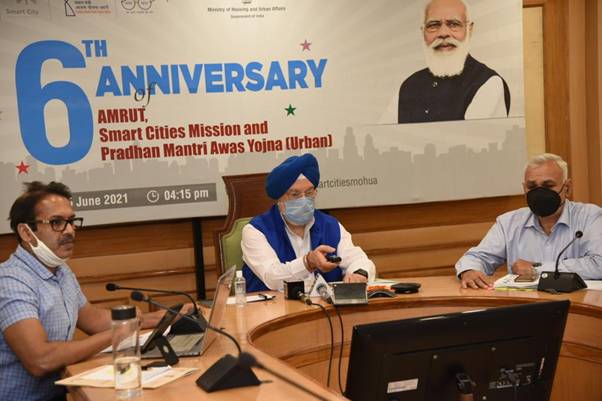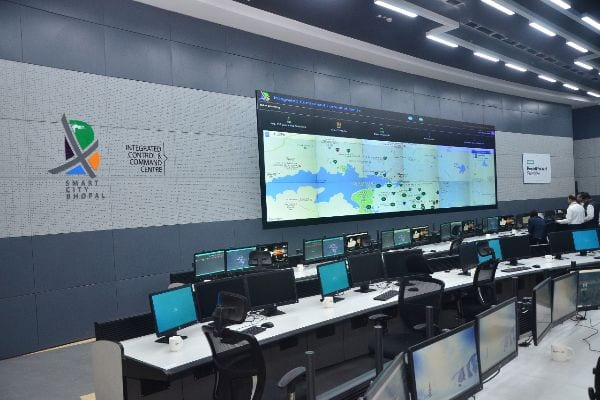The Ministry of Housing and Urban Affairs (MoHUA) organised an online event on here today to commemorate 6 years of the three transformative Urban Missions vis. Smart Cities Mission (SCM), Atal Mission for Urban Rejuvenation and Urban Transformation (AMRUT) and Pradhan Mantri Awas Yojana-Urban (PMAY-U), which were launched by Prime Minister Shri Narendra Modi, on 25th June, 2015. The Anniversary event highlighted some of the important initiatives being implemented under Smart Cities Mission. The event was presided by Shri Hardeep S. Puri, Minister of State (Independent Charge), Housing and Urban Affairs and was attended by key urban stakeholders from Central and State Governments including Principal Secretaries of States/UTs, Municipal Commissioners of Cities, and MDs/CEOs of Smart Cities. The date also marked the 45 years of establishment of National Institute of Urban Affairs, an autonomous body of MoHUA, tasked to bridge the gap between research and practice on issues related to urbanization.

Pradhan Mantri Awas Yojana – Urban (PMAY)
Union Minister of State (I/C), MoHUA, Shri Hardeep Singh Puri released a short movie that encapsulated the Mission’s journey of six glorious years in fulfilling the dream of a pucca house for millions of Indians. In line with the vision of Prime Minister- ‘Housing for All’ by 2022, PMAY-U has registered outstanding success. So far, about 1.12 crore houses have been sanctioned for its beneficiaries, out of which more than 83 lakh houses are grounded and more than 50 lakh completed.
At the event which was attended by Secretary, MoHUA, Shri Durga Shanker Mishra, other senior officials of MoHUA, States/UTs/ULBs, a short movie contest ‘Khushiyon ka Ashiyana’ was declared open for students, youths, non-governmental organisations, institutions and individual/groups in the run up to India’s 75th Independence. Accordingly, 75 such movies under diverse aspects of the Mission like Housing for All, Sapno ka Aashiyana, Laabharthiyon ki Zuban Se, Women Empowerment, Livelihood, Life Transformation will be selected by a jury of eminent persons. 25 awards each under the Gold, Silver and Bronze categories will be given away along with a cash prize and citation from MoHUA.
A video testimonial ‘Ghar Hua Apna, Pura Hua Sapna’ of PMAY-U beneficiaries who have experienced life transformation on moving into a pucca house were also released at the event.
In addition, MoHUA announced that 75 ‘Awas Par Samvaad’ workshops will be held across States/UTs in Schools/Colleges/Institutions to propel the ‘Housing for All’ as a universal theme.
PMAY (U) implementation has followed the ethos of Cooperative Federalism in which MoHUA delegated powers to States / UTs for project formulation, appraisal and approval. Further, the success of the Mission can be attributed to its robust financial model of which, Direct Benefit Transfer has been a key element. Besides, use of Information Technology for real time monitoring and technological innovation, additional funding through ExtraBudgetary Resource over and aboveBudgetary allocations have been major contributors. The houses sanctioned so far under the Mission involve an investment of ₹7.35 lakh crore with Central Assistance of ₹1.81 lakh crore. As of now, over ₹ 100,000 crore of Central Assistance has already been released. Infusion of such a large amount of funding has propelled the economy. For sustained funding support to keep the pace of construction activities, over and above Budgetary support, a corpus of ₹60,000 crore through EBR was mobilized under National Urban Housing Fund (NUHF) wherein ₹43,000 Cr has already been drawn. Affordable Housing Fund ₹ 20,000 Cr are being utilized in the last 3 years.
Acknowledging the diversity in housing demand across various income groups of the country, for the first time interest subsidy on home loans have been given to Middle-Income Group having annual income of upto ₹18 Lakh under PMAY-U’s Credit Linked Subsidy Scheme (CLSS). Nearly 16 lakh beneficiaries belonging to Economically Weaker Sections (EWS), Lower Income Group (LIG) and MIG have so far been brought under the fold of CLSS.
Due to its forward and backward linkages to other sectors, the current investment made by the Government in the sector, has created almost an estimated 689 crore person days of employment translating into around 246 lakh jobs and led to consumption of 370 Lakh MT of cement and 84 Lakh MT of steel.
Over the years, the Government has taken up various measures for adopting construction technology reforms in the housing. MoHUA organised Global Housing Technology Challenge India (GHTC-India) in 2019 to identify and mainstream globally best available proven construction technologies that are sustainable, green and disaster-resilient to enable a paradigm shift in affordable housing. On 1st January 2021, Prime Minister Shri Narendra Modi ushered the Nation into a new era of construction technology. He laid the foundation of six Light House Projects (LHPs) in the country through video conference. The LHPs, that are being built under PMAY-U showcase the best of new-age alternate global technology in housing construction sector, selected through GHTC-India.
As a response to the reverse migration taking place due to the COVID-19, MoHUA launched Affordable Rental Housing Complexes (ARHCs), a sub-scheme under PMAY(U) for urban migrants/ poor. Under Model 1, a total of 2,588 houses have been made operational in Chandigarh and Surat (Gujarat)and RFPs are issued for 6,649 houses across other States. Under Model 2, so far, proposals for about 80,000 ARHC units have been received from Public/Private entities in 17 States/UTs. Second round of EoI has been issued on for shortlisting of additional entity with last date as 30th June 2021. Investment under ARHCs is expected to create 11.74 crore person days of employment with 3.89 crore direct and 7.84 crore indirect in nature. In terms of jobs, it works out to be a total of 4.19 1akh with 1.39 lakh direct and 2.80 lakh indirect jobs. ARHC has elicited remarkable response on ground. Under Model 2 of the scheme, proposals from public/private entities for about 80,000 units have been received from across 17 States/UTs.Encouraged by the traction, MoHUA has issued second EoI for inviting proposals under ARHCs.Nearly 22,000 PMAY-U houses were used as COVID facilities.
As the Mission moves ahead, there has been a need to address life transformation issues that arise out of moving into a new house and neighbourhood. To address this, ANGIKAAR, a campaign for social change management was initiated by ‘Housing for All’ (HFA) Mission on 29th August 2019. It has achieved the objective to build capacities of PMAY -U beneficiaries in adapting to change though door-to-door awareness on best practices in water & energy conservation, health, hygiene, sanitation and financial literacy. Further, an enabled environment was created through convergence with various Urban Missions and schemes of other Central Ministries. It is an unique initiative in the urban housing sector that embraced and brought into its fold welfare oriented schemes of the State and Central Government.
A campaign of this magnitude in the urban housing sector is a result of the collective efforts and proactive participation of PMAY (U) beneficiaries, States/UTs/ULBs/ and elected representatives. Around 18,500 ANGIKAAR Resource Persons were trained by about 2,200 specialists of City Level Technical Cells (CLTCs) working in 4,427 cities of PMAY (U). They acted as foot soldiers and helped propagate the message of the campaign.
Atal Mission for Rejuvenation & Urban Transformation (AMRUT)
Atal Mission for Rejuvenation & Urban Transformation (AMRUT) is the first focused national water Mission and was launched on 25th June, 2015 in 500 cities covering 60% of the urban population. All cities having population above 1 lakh are covered under Mission. Providing piped water supply and sewerage & septage management in Mission cities is the major focus of the Mission. Storm water drainage, non-motorized urban transport and green spaces & parks are minor components of Mission. Overall Mission allocation is ₹1 lakh crore including central share of ₹50,000 crore. State action plans amounting to ₹77,640 crore for basic infrastructure projects were approved, against which projects worth ₹79,772 crore have been grounded. So far, work worth ₹52,477 crores (66%) has been carried out.
So far, 105 lakh household water tap connections and 78 lakh sewer/ sepatage connections have been provided under Mission and in convergence with other schemes. Sewage Treatment Plants (STPs) capacity worth 1,240 MLD have been created, of which 907 MLD is being recycled/ reused. Another, 4,800 MLD STP capacity is under development. Through projects in drainage sector, 1,840 water logging pointshave been eliminated. 1,850 parks & green spaces (3,770 acre) added. 800 parks (1,600 acre) are in progress. 180 projects in non-motorized urban transport sector have been completed.
AMRUT has a reform agenda with focus on e-Governance, energy audit, credit rating of ULBs, efficient town planning, online building permission system and raising funds by floating municipal bonds by ULBs. Under energy audit, 88 lakh streetlights have been replaced with energy efficient LED lights against target of 101 lakh leading to energy savings of 193 crore units and reduction in CO2 emission by 15.4 lakh tons per annum. Energy audit of water pumps have been completed in 396 cities in 27 States/UTs. 11,385 water pumps are identified for replacement, of which 667 pumps have been replaced. As per The Energy and Resources Institute (TERI), 84.6 lakh tons carbon footprint reduced through various initiatives under AMRUT.
Credit rating work has been awarded for 485 cities and completed in 470 cities. 164 cities have received Investible Grade Rating (IGR), including 36 cities with rating of A- or above. Ten ULBs namely Ahmedabad, Amravati, Bhopal, Ghaziabad, Hyderabad, Indore, Lucknow Pune, Surat and Visakhapatnam have raised ₹3,840 crore through issuance of municipal bonds.
Online Building Permission System (OBPS) withseamless integration with internal/ external agencies has been made operational in 2,465 towns including 452 AMRUT cities. India’s rank in Ease of Doing Business (EODB) in construction permits has jumped to 27 in World Bank’s Report (DBR)-2020 from 181 in 2018.
Master Plans of AMRUT cities are being prepared based on Geographical Information System (GIS) through a sub-scheme costing ₹515 crore. National Remote Sensing Centre (NRSC), Hyderabad has been roped in to provide satellite photos and for digitization of city maps. So far,final GIS based Master Plans have been prepared for 66 cities and drafts plans have been prepared for another 61 cities. In order to ensure efficient land use, a sub-Scheme on Local Area Planning and Town Planning Scheme (LAP/TPS)in 25 cities costing ₹50 crore is in progress.
Smart Cities Mission
- Physical progress in SCM:
SCM is a transformational Mission aimed to bring about a paradigm shift in the practice of urban development in the country. Of the total proposed projects under SCM, 5,924 projects (115% by number) worth ₹1,78,500 crore (87% by value) have been tendered so far, work orders have been issued for 5,236 projects (101% by number) worth ₹1,46,125 crore (71% by value). 2,665 projects (52% by number) worth ₹45,080 crore (22% by value) have also been fully completed and are operational (as on 23 June 2021).
- Financial Progress in SCM:
- Smart Cities Mission has demonstrated notable success in all projects, notably PPP projects. This success is noteworthy for three reasons, as under.
- Total value of successful PPP projects: 212 PPP projects worth ₹ 24,964 crore have been grounded/ completed stage in the Smart Cities Mission.
- Geographical spread across 57 cities: These projects are located across 57 cities and include not only in big cities but also smaller cities.
- Diverse sectoral mix of successful PPP projects: These successful PPP projects span diverse (10+) and unique sectors.
- It is also noteworthy that average monthly expenditure in the Smart Cities Mission has almost doubled in the last year, despite the challenges faced due to COVID. The efforts put by the team to start and continue construction activities even during challenging times, was appreciated by the Minister and Secretary, MOHUA.
- Key Result areas:
- Projects developed under the Smart Cities Mission are multi-sectoral and mirror the aspirations of the local population. As on date, 70 Smart citieshave developed and operationalised their Integrated Command and Control Centres (ICCCs) in the country. These operational ICCCs functioned as war-rooms for COVID management, and along with other smart infrastructure developed under the mission, helped cities in fighting the pandemic through information dissemination, improving communication, predictive analysis and supporting effective management. These are being developed across all 100 Smart Cities of the country.
- Looking at other beach-head projects, 310 Smart Road projects have been completed and 459 Smart road projects are at tender/implementation stage.
- Similarly, the Smart solar, Smart Water and Vibrant Public Spaces projects are heading towards progressive paths in the Mission. (Details below)
| Sector | Completed | In Progress | ||
| Projects | Cost | Projects | Cost | |
| Integrated Command and Control Centre | 70 | 8,100 | 18 | 2,991 |
| Smart Roads | 310 | 5,362 | 459 | 21,518 |
| Smart Solar | 57 | 563 | 38 | 481 |
| Smart Water | 101 | 5,081 | 185 | 18,146 |
| PPP | 123 | 4,420 | 178 | 25,049 |
| Vibrant Public Places | 72 | 1,662 | 76 | 8,551 |
| *All cost in Rs. crore | ||||
- Important Launches/ releases during the event:
- India Smart Cities Awards 2020:
Today, the Smart City awards results for 2020 weredeclared. These awards were given across the themes of Social Aspects, Governance, Culture, Urban Environment, Sanitation, Economy, Built Environment, Water, Urban Mobility. Some interesting themes were added too this year for Sustainable Business model of ICCC and Innovation award specially in COVID Management.
Indore & Surat won the City Award jointly this year for their overall development and Uttar Pradesh won the State award. The detailed list of winners under each of the themes mentioned above and categories is enclosed at ‘Annexure 1’.
- Climate Smart Cities Assessment Framework 2.0
The Climate Smart Cities Assessment Framework (CSCAF) 2.0 was launched in September, 2020 with an aim to provide an overarching roadmap to formulate, implement and monitor urban climate actions in India. Intended as a tool for cities to evaluate their current performance and build on the same, the framework has 28 diverse indicators covering 96 data points across five thematic areas.126 cities, including 100 Smart Cities and 26 cities with population over 500,000, participated in the 2020 assessment cycle.
The top 9 performing cities which have been awarded 4 star rating are Surat, Indore, Ahmedabad, Pune, Vijayawada, Rajkot, Visakhapatnam, Pimpri-Chinchwad and Vadodara. The results of CSCAF 2.0 are available online at http://amplifi.mohua.gov.in .
- Data Maturity Assessment Framework 2.0
The experience of cities in using data and technology during this COVID pandemicand build effective response mechanisms to prevent, contain and address the crisis, has reinforced their beliefs in the power and potential of data and pushed them towards the vision of becoming DataSmart.
Every year, the Smart Cities are being ranked on the Data Maturity Assessment Framework so that ULBs continue to invest in developing and strengthening their data ecosystems. To understand the maturity and readiness of cities in implementing the DataSmart Cities Strategy and to better recognize and capture the achievements of cities in the field of data, the 2nd cycle of Data Maturity Assessment Framework was launched in November 2020.
Over the past few months, all 100 Smart Cities actively participated in this exercise and have showcased the maturity and advancement in the past 2 years. A total of 42 cities have attained a certification level – out of which top 4 cities – Surat, Pimpri Chinchwad, Bhopal and Pune – have been certified as ‘Connected’, 8 cities are at ‘Enabled’, 11 at ‘Explorer’ level and 19 cities at the ‘Initiator’ level. Rest 58 cities have commenced their data journey and are at a ‘Beginner’ level. The results of the assessment are available at http://dmaf.mohua.gov.in.
MoHUA is also committed to the continuous capacity building of the City Data Teams and of the country’s urban data ecosystem at large. Guidelineon‘Building Data Alliances’ was launched to facilitate cities in developing sustainable data alliances which can help unlock the combinatorial power of data and promote co-creation and innovation.Along with the reference document on conducting a city data policy and conducting hackathons, these efforts of leveraging data and technology will help transform the lives of citizens by enabling improved decision making and inclusive governance.
- ICT initiatives under Smart Cities
-
- Release ofICCC Maturity Assessment framework (IMAF):
ICCC Maturity Assessment Framework (IMAF) is a self-assessment tool kit developed to assess the maturity of Integrated Command and Control Centres (ICCC) across key aspects of functionality, technology, governance and citizen/stakeholders engagement.This tool kit will help cities identify areas of improvement in their ICCCs to deliver better services to the citizens. The framework has been finalized after several rounds of deliberations, public consultations and suitably incorporating the views of all concerned stakeholders.
The cities shall be encouraged to reap the benefit of the effort that has gone into the preparation of this framework and undertake the exercise of self-assessment, so as to unlock the potential of ICCCs implemented / being implemented in cities. With this framework cities will be able to improve data-driven governance and move towards the achievement of outcomes that were intended to as part of the cities ICCC.
-
- Release of Model RFP for ICCC:
The Integrated Command and Control Centre (ICCC), being set up in each of the 100 smart cities are envisioned to help better address the needs of citizens, thus channelising citizen-centric holistic governance and act as a decision support system. Smart Cities Mission has already developed ICCC in 69 cities and 31 more are in the pipeline. Since the implementation of first ICCC in Year 2017, there have been lot of learnings from field level deployments, need for improving standardisation in implementation process, wider adoption of PPP-MII guidelines, emerging technologies and focus on data driven governance.It has also been observed that after publishing of RFPs by the cities, the industry organisations have been raising concerns on restrictive product/vendor specific requirements being reflected in such RFPs which are deterrent to a level playing field for bidders, including domestic players.
Keeping this in mind, an updated Model RFP for ICT/ICCCwas released with an intent to help cities expedite ICCC implementation and build awareness on mission guidelines/ advisories, standards & best practices. The objective is also to harmonize various RFP clauses and terms & conditions.
-
- Release of Smart Cities ICT standards
Standardization journey under Smart Cities Mission began in Dec 2018 at Varanasi with an International Conference organised by Bureau Of Indian Standards (BIS).The sustained engagement with BIS and industry ecosystem over last 2+ years has resulted in release of first sets of 4 indigenous ICT standards & adoption of additional 4 (four) international standards in January this year, which will facilitate interoperability between products in a multi-vendor, multi-network and multi-service environment that exists in a smart city. 7 (Seven) additional standards for ICT and eGovernance under Smart Cities Mission were releasedtoday.
- India Smart Cities Fellows Report
The India Smart Cities Fellowship Program was initiated by the Ministry of Housing and Urban Affairs under the Smart City Mission to promote youth leadership and usher vibrancy in the design of India’s urban future. Every year, the Fellowship brings together a cohort of bright and driven professionals from intersectional urban domains, and fosters an environment of peer learning and healthy competition, eventually training them to work effectively with cities.
In its second year, the cohort of 46 Fellows spent their tenure developing 13 projects to impact the sectors of spatial planning, citizen engagement, tourism, local economies, urban mobility, environment, disaster management, water, education, migration and health. The Compendium of Projects of the 2020-2021 cohort is the culmination of a year-long attempt by fellows at problem-solving and innovation in 13 Smart Cities of India.
- TULIP Report
`TULIP-The Urban Learning Internship Program’ was launched last year on 4th June2020 in partnership with AICTE. TULIP is a platform to connect graduates to Urban Local Bodies and Smart Cities to co-create new solutions for our cities.A report on performance of the program was released today.
The platform has received a significant response from the educated youth in the nation and more than 16,500 internship opportunities have been posted on the TULIP Portal out of which around 1,220 internships are ongoing and 467 Internships have already been completed. We expected the number to be much higher but for the uncertainties created by COVID and the unforeseen lockdowns required to be imposed.
- NIUA Knowledge products
- Handbook of Urban Statistics: Ensuring Visibility of Persons with Different Abilities (Divyangs) in Indian Cities
The Handbook of Urban Statistics-2020 is the first of its kind document with a special focus on Persons with Disabilities (PwDs). It captures the data related to the nature and cause of disability, the socio-economic condition of PwDs and their access to various physical and social infrastructure, along with recent data on India’s demography and socio-economic conditions of the people, access to basic amenities and housing.
It serves as a ready reckoner for policy-makers and urban planners in evidence-baseddecision making for design and policy leading to more inclusive and accessible cities. It will help them better understand the infrastructure needs of PwDs in sectors such as housing, transport, health, ICT-led solutions, education, and urban governance.
This report was undertaken as part of the Building Accessible Safe Inclusive Indian Cities Program with support from Foreign, Commonwealth and Development Office (FCDO), UK.
The Cities Insights Report is yet another initiative under the Building Accessible Safe Inclusive Indian Cities (BASIIC) Programme at the National Institute of Urban Affairs. The report investigates the economic and social inequity faced by PWDs and other marginalized communities living in cities by comparing and contrasting global and national strategies that have prioritized universal access to urban services and infrastructure.
The cornerstone of the report are the initiatives that have been adopted by thirteen select smart cities in India, particularly on parameters to understand the cities’ initiatives on disability-inclusive development and identify funding and implementation strains.
The report stresses on the need for an integrated, participatory, and collaborative approach for city stakeholders, and proposes various mechanism i.e. city-wide audit of infrastructures services, developing disaggregated database on persons with disabilities, enable local partnerships, and develop robust evaluation platforms to monitor the progress of inclusive interventions at city level.
-
- CITIIS – Knowledge Products:
Launched in partnership with the French Development Agency and the European Union in 2018 as a complement to the Smart Cities Mission, the CITIIS program has a novel approach of developing demonstrative projects while also furthering the agenda of sustainability and innovation in urban infrastructure. Its unique maturation phase methodology helped plan and design robust projects. Throughout this exercise, the 12 Smart cities under the program benefited from the continuous mentorship of various stakeholders. These projects showcase the far-reaching benefits of incorporating a structured design approach, stakeholder engagement, strategic monitoring, and knowledge sharing. Two knowledge products were launched today.
1. The Toolkit on ‘Developing Innovative, Integrated, and Sustainable Urban Development Projects using the CITIIS Model,’ outlines a step-by-step approach to project development by deconstructing the elements of the 20-step process, and suggests tools for each step. The benefit of this document is that urban managers are able to ascertain a broader strategic perspective of all the activities at hand that go into the preparation of an urban infrastructure project.
2. The Handbook on ‘CITIIS and the Sustainable Development Goals,’ is a mapping of CITIIS targets with SDG targets, and discusses the crucial role that local action plays in delivering a large part of the national commitments to the SDGs.
Annexure – I: List of winning Smart Cities under ISAC 2020
| Project Award: Theme-wise Winners/ Joint-winners | |||
| Social Aspects |
|
||
| Governance |
|
||
| Culture | Joint Winners (Indore and Chandigarh)
Indore: Conservation of Heritage 3. Gwalior: Digital Museum |
||
| Urban Environment | Joint Winners (Bhopal and Chennai)
Bhopal: Clean energy 3. Tirupati – Renewable Energy Generation |
||
| Sanitation | Joint Winners (Tirupati and Indore)
Tirupati: Bioremediation & Bio-Mining 3. Surat: Conservation through Treated Wastewater |
||
| Economy |
Joint Second (Tirupati and Agra)
|
||
| Built Environment |
|
||
| Water | Joint Winners (Dehradun and Varanasi)
Dehradun: Smart Water Metering Water ATM Varanasi: Eco-Restoration of Assi River
|
||
| Sustainable Business Model of ICCC | Agartala ICCC | ||
| Urban Mobility |
|
||
| Innovation Award | |||
| Innovative Idea Award | Indore: Carbon Credit Financing Mechanism | ||
| Covid Innovation Award | Joint Winners: Kalyan-Dombivali&Varanasi | ||
| Covid Innovation Award
(round-wise winners) |
Round 1: Chennai | ||
| Round 3: Bengaluru | |||
| Round 4: Saharanpur | |||
| City Award | |||
| Overall Winner | Joint Winners: Indore & Surat | ||
| Round 1
(round-wise recognition) |
|
||
| Round 2+FT
(round-wise recognition) |
|
||
| Round 3
(round-wise recognition) |
|
||
| Round 4
(round-wise recognition) |
|
||
Annexure II: List of winners under the State/UT Award category
| State Award: | ||
| State Award |
|
|
| UT Award | ||
| UT Award |
|
|
Annexure III: List of winners under the Smart Cities Leadership Award
| Smart Cities Leadership Award: |
|












